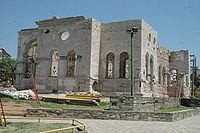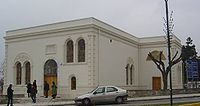
Gazi Evrenos
Encyclopedia


Ottoman Empire
The Ottoman EmpireIt was usually referred to as the "Ottoman Empire", the "Turkish Empire", the "Ottoman Caliphate" or more commonly "Turkey" by its contemporaries...
military commander, with an unlikely longevous career and lifetime. He served as general under Süleyman Pasha
Suleyman Pasha (son of Orhan)
Suleyman Pasha was the eldest son of Orhan I, the second bey of the newly established Ottoman Empire.-Assault on Byzantium:Suleyman Pasha struck a bold blow to the weakened Byzantine Empire on behalf of his race, which gave the Turks a permanent establishment on the European side of the Hellespont...
, Murad I
Murad I
Murad I was the Sultan of the Ottoman Empire, from 1361 to 1389...
, Bayezid I
Bayezid I
Bayezid I was the Sultan of the Ottoman Empire, from 1389 to 1402. He was the son of Murad I and Valide Sultan Gülçiçek Hatun.-Biography:Bayezid was born in Edirne and spent his youth in Bursa, where he received a high-level education...
, Süleyman Çelebi
Süleyman Çelebi
Süleyman Çelebi was an Ottoman prince and a co-ruler of the empire for several years during the Ottoman Interregnum. - Back ground :...
and Mehmed I
Mehmed I
Mehmed I Çelebi was a Sultan of the Ottoman Empire from 1413 to 1421. He was one of the sons of Bayezid I and Valide Sultan Devlet Hatun Mehmed I Çelebi (Ottoman: چلبی محمد, Mehmed I or Mehmed Çelebi) (1382, Bursa – May 26, 1421, Edirne, Ottoman Empire) was a Sultan of the Ottoman Empire...
.
Byzantine sources mention him as Εβρενός, Ἀβρανέζης, Βρανέζης, Βρανεύς (?), Βρενέζ, Βρενέζης, Βρενές. A persistent Greek legend maintains that Evrenos' father was a certain Ornos, renegade Byzantine
Byzantine Empire
The Byzantine Empire was the Eastern Roman Empire during the periods of Late Antiquity and the Middle Ages, centred on the capital of Constantinople. Known simply as the Roman Empire or Romania to its inhabitants and neighbours, the Empire was the direct continuation of the Ancient Roman State...
governor of Prusa who defected to the forces of Osmanli
Ottoman Empire
The Ottoman EmpireIt was usually referred to as the "Ottoman Empire", the "Turkish Empire", the "Ottoman Caliphate" or more commonly "Turkey" by its contemporaries...
, and then on to Karasi, after the fall of Prusa, in 1326. He was known as Isa Bey Prangi, buried in the village of Prangi (also known as Sırcık or Kırcık in Ottoman sources), a busy ferry-place on the Evros
Maritsa
The Maritsa or Evros , ) is, with a length of 480 km, the longest river that runs solely in the interior of the Balkans. It has its origin in the Rila Mountains in Western Bulgaria, flowing southeast between the Balkan and Rhodope Mountains, past Plovdiv and Parvomay to Edirne, Turkey...
river about 6 km (4 mi) east from Didymoteicho
Didymoteicho
Didymóteicho is a town located in the eastern part of the Evros peripheral unit of Thrace, Greece. It is the seat of the municipality of the same name. The town sits on a plain and located south east of Svilengrad, south of Edirne, Turkey and Orestiada, west of Uzunköprü, about 20 km north...
. Stanford J. Shaw
Stanford J. Shaw
Stanford Jay Shaw was an American historian, best known for his works on the late Ottoman Empire, Turkish Jews, and the early Turkish Republic...
and Joseph von Hammer regard Evrenos as a Byzantine convert to Islam.
Οriginally, Gazi Evrenos was a noble dignitary, a beg in the principality of Karasi, joining the Ottomans only after their conquest of the beylik in 1345. He led many crucial Ottoman campaigns and battles in Rumelia
Rumelia
Rumelia was an historical region comprising the territories of the Ottoman Empire in Europe...
, Thrace
Thrace
Thrace is a historical and geographic area in southeast Europe. As a geographical concept, Thrace designates a region bounded by the Balkan Mountains on the north, Rhodope Mountains and the Aegean Sea on the south, and by the Black Sea and the Sea of Marmara on the east...
, Thessaly
Thessaly
Thessaly is a traditional geographical region and an administrative region of Greece, comprising most of the ancient region of the same name. Before the Greek Dark Ages, Thessaly was known as Aeolia, and appears thus in Homer's Odyssey....
, Macedonia
Macedonia (region)
Macedonia is a geographical and historical region of the Balkan peninsula in southeastern Europe. Its boundaries have changed considerably over time, but nowadays the region is considered to include parts of five Balkan countries: Greece, the Republic of Macedonia, Bulgaria, Albania, Serbia, as...
and Serbia
Serbia
Serbia , officially the Republic of Serbia , is a landlocked country located at the crossroads of Central and Southeast Europe, covering the southern part of the Carpathian basin and the central part of the Balkans...
. After having participated in the Ottoman conquest of Adrianopolis
Adrianópolis
Adrianópolis is a town and municipality in the state of Paraná in the Southern Region of Brazil.-References:...
in 1362, Evrenos was appointed to Ucbeyi (Marcher Lord) of Thessaly. He and his akincis
Akinci
Akıncı were irregular light cavalry,scout divisions and advance troops of the Ottoman Empire's military. When the pre-existing Turkish ghazis were incorporated into the Ottoman Empire's military they became known as "akıncı." They were one of the first divisions to face the opposing military and...
fought in the Battle of Kosovo
Battle of Kosovo
The Battle of Kosovo took place on St. Vitus' Day, June 15, 1389, between the army led by Serbian Prince Lazar Hrebeljanović, and the invading army of the Ottoman Empire under the leadership of Sultan Murad I...
(1389) and the Battle of Nicopolis
Battle of Nicopolis
The Battle of Nicopolis took place on 25 September 1396 and resulted in the rout of an allied army of Hungarian, Wallachian, French, Burgundian, German and assorted troops at the hands of an Ottoman force, raising of the siege of the Danubian fortress of Nicopolis and leading to the end of the...
(1396). Evrenos conquered Keşan
Kesan
Keşan is the name of a district of Edirne Province, Turkey, and also the name of the largest town in the district. Keşan has a population of 54,314 during the winter; in the summer this increases to 70,000 because of an influx of tourists...
, İpsala
Ipsala
İpsala is a town and district of Edirne Province in northwestern Turkey. It is the location of one of the main border checkpoints between Greece and Turkey. The Greek town opposite İpsala is Kipoi. The population is 8,332 and 30,112 ....
, Komotini
Komotini
Komotini is a city in Thrace, northeastern Greece. It is the capital of the region of East Macedonia and Thrace and of the Rhodope regional unit. It is also the administrative center of the Rhodope-Evros super-prefecture. The city is home to the Democritus University of Thrace, founded in 1973...
, Feres
Feres, Evros
Feres is a town and a former municipality in the Evros peripheral unit, East Macedonia and Thrace, Greece. Since the 2011 local government reform it is part of the municipality Alexandroupoli, of which it is a municipal unit. Population 9,839...
, Xanthi
Xanthi
Xanthi ; is a city in Thrace, northeastern Greece. It is the capital of the Xanthi peripheral unit of the periphery of East Macedonia and Thrace.-History:...
, Maroneia
Maroneia
Maroneia is a village and a former municipality in the Rhodope peripheral unit, East Macedonia and Thrace, Greece. Since the 2011 local government reform it is part of the municipality Maroneia-Sapes, of which it is a municipal unit. Population 7,644...
, Serres
Serres
Serres is a city in Greece, seat of the Serres prefecture.Serres may also refer to:Places:* Serres, Germany, a part of Wiernsheim in Baden-WürttembergIn France:* Serres, Aude in the Aude département...
, Monastir
Bitola
Bitola is a city in the southwestern part of the Republic of Macedonia. The city is an administrative, cultural, industrial, commercial, and educational centre. It is located in the southern part of the Pelagonia valley, surrounded by the Baba and Nidže mountains, 14 km north of the...
, and, in 1397, Corinth
Corinth
Corinth is a city and former municipality in Corinthia, Peloponnese, Greece. Since the 2011 local government reform it is part of the municipality Corinth, of which it is the seat and a municipal unit...
. He founded the town Yenice-i Vardar
Giannitsa
Giannitsa is the largest town and a former municipality in Pella regional unit, Greece. Since the 2011 local government reform it is part of the municipality Pella, of which it is a municipal unit...
, modern Giannitsa. The Greek inhabitants of Gianitsa (Ottoman: Yenice Vardar) down to this century displayed reverence for "Gazi Baba," that is, "papa Gazi".
Gazi Evrenos Bey was father of seven sons (Khidr-shah, Isa, Suleyman, Ali
Ali Beg
Ali Beg or Ali Bey Evrenos-ogly was Ottoman military commander in 15th century. He was one of the sons of Evrenos, an Ottoman general....
, Yakub, Barak, Begdje) and several daughters.
Among the numerous descendants of lord Gazi Evrenos, apparently the memory of some has dived into oblivion, as their deeds got incorporated into the achievements of their illustrious forefather. This explains the legendary, yet unlikely, 129-year lifespan of lord Gazi.
Together with the Mikhal-oghullari, Malkoz-oghullari and the Turakhan-oghullari, Evrenos' descendants, the Evrenos Oghullari (Evrenosoğulları), constitute one of the four ancient families, that effectively formed the Ottoman warrior nobility.
Gazi Evrenos died at an advanced age in Yenice-i Vardar. He was buried in a mausoleum there in 1417. The mausoleum survives but was badly mutilated in 19th century and served for a time as an agricultural store.
As one of the most successful Ottoman commanders, Evrenos acquired a considerable amount of wealth and founded numerous endowments (awqaf
Waqf
A waqf also spelled wakf formally known as wakf-alal-aulad is an inalienable religious endowment in Islamic law, typically denoting a building or plot of land for Muslim religious or charitable purposes. The donated assets are held by a charitable trust...
). Several monuments attributed to him survive in southeastern Europe. Of primary importance is his mausoleum, or türbe
Turbe
Türbe is the Turkish word for "tomb", and for the characteristic mausoleums, often relatively small, of Ottoman royalty and notables. It is related to the Arabic turba, which can also mean a mausoleum, but more often a funerary complex, or a plot in a cemetery.-Characteristics:A typical türbe...
, with its accompanying epitaph in Giannitsa. A hammam
Hammam
A Turkish bath is the Turkish variant of a steam bath, sauna or Russian Bath, distinguished by a focus on water, as distinct from ambient steam....
of Evrenos stands to the south of the mausoleum. Two other monuments stand in Greek Thrace.
External links
- Mausoleum of Gazi Evrenos in Giannitsa (Yenitsa), Greece.
See also
- Lala Shahin PashaLala Shahin PashaLala Shahin Pasha was the first Beylerbey of Rumelia. He was one of commanders in Battle of Maritsa and the leader of the Battle of Bileća ....
- Çandarlı Kara Halil Hayreddin PashaÇandarli Kara Halil Hayreddin PashaÇandarlı Kara Halil Hayreddin Pasha was the first vizier of Murad I's reign. He was also the first in Ottoman history who held the title "Grand Vizier", the first who had a military background and the first member of the illustrious Çandarlı Family to hold high office...
- Umur the LionUmur the LionUmur Beg or Ghazi Umur , also known as Umur Pasha was the Emir of Aydin from 1334 to 1348. Umur was described in a chronicle Düstürnâme-i Enverî, which was written by Enverî during the reign of Mehmed II, as the "Lion of God" leading just and holy war of conquest against the "miscreants" and...

